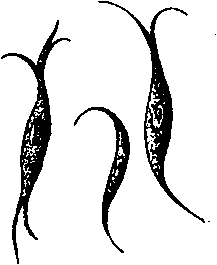Osseous Or Bony Tissue
Description
This section is from the book "Wonders Of The Human Body", by Auguste Le Pileur. Also available from Amazon: Wonders of the Human Body.
Osseous Or Bony Tissue
Osseous Or Bony Tissue, which is composed principally of an anatomical element called osteoplasm. It is compact in some parts of the bones, and spongy in others. This tissue is traversed by infinitely ramified conduits, called the canals of Havers, which contain the blood-vessels and the medullary substance or marrow.

Fig. 4. Laminated fibres in the first stage of development.
Cartilaginous And Fibro-Cartilaginous Tissue
Cellular or connective tissue, more exactly named laminated tissue, formed of laminated fibres, long, flattened, undulated filaments in bundles, and of fibres appertaining to elastic tissue. In nearly every part of the body this substance fills the spaces between the tissues or between the bundles of the fibres of which they are made up: on the surface of the body and of its cavities, and around the organs, it is disposed in enveloping membranes.
Adipose Tissue
Adipose Tissue is formed of cells or vesicles containing fat It is never found except in the cellular tissue and at the points where this last is least dense.
These two tissues united are commonly designated by the term fat, or fatty layer, but they are distinct notwithstanding, and neither wasting nor increase of fat causes any change in the mass of the cellular tissue, but only in the quantity of fat contained in the cells of the adipose tissue.
Epithelial Tissue
Epithelial Tissue has for its anatomical elements, cells or free nuclei, which form by juxtaposition either a very thin single layer, or several superposed layers. It is of this tissue that the epidermis and the epithelium, a kind of internal epidermis, are essentially composed.
Continue to:
